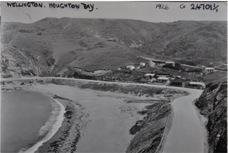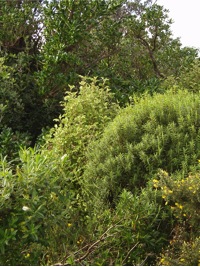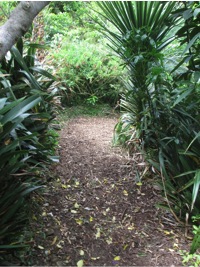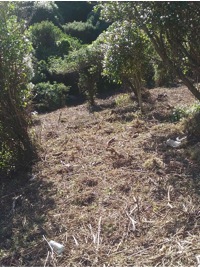July 4, 2018
Welcome to part three of our three-part look at the Houghton Valley Progressive Association in the lead up to their AGM on July 8 (4 pm in the hall). We hope to see you there! In this newsletter we look at how the HVPA could be active in promoting community stewardship (kaitiakitanga) of our valley and coastline. These are the questions we have been asking about potential stewardship of Houghton Valley:
- How can we care for the soil, the water, the air, the plants and the creatures in our valley and our bay?
- How can the HVPA help the community pool their environmental care resources – knowledge and labour – to achieve the best possible result?
- How can we develop kaitiakitanga as a lifestyle, a cultural, a recreational and an educational opportunity?
Although stewardship encompasses many aspects of the environment, forest restoration has been one of the more popular activities, so we will look briefly at what has been happening with the restoration of our local reserves.
Forest regeneration in our valley
 Due to early farming in Houghton Valley our present forest cover is secondary growth developed from completely bare hillsides. Once farming ceased the slopes quickly reverted to gorse, which regularly went up in flames around the 5th of November. It was not until sky rockets were banned that natural regrowth started to make good headway.
Due to early farming in Houghton Valley our present forest cover is secondary growth developed from completely bare hillsides. Once farming ceased the slopes quickly reverted to gorse, which regularly went up in flames around the 5th of November. It was not until sky rockets were banned that natural regrowth started to make good headway.
Intentional planting of natives in the began in the 1970s. The corner of Buckley Road and Houghton bay Road was one of the first to be planted, to ‘beautify’ the newly completed rubbish tip. In the 1980s, Kae Miller planted natives on Te Raekaihau Headland (the reserve at the end of View Rd South), and other locals planted more fire resistant natives to try and prevent the constant setbacks.
Forest restoration has blossomed in Houghton Valley, and recently there have been several different groups planting at Te Kawakawa Commons, Buckley Road Reserve, the gully between the school and the playcentre, the zigzag (steps down to Lyall Bay), Te Raekaihau Headland, Cave Road, and Te Raekaihau Point. The Wellington City Council has also been involved, providing hundreds of plants for locals to plant, and ranger assistance.
Different approaches to forest restoration
 All these groups have been working independently and following their own ideas about environmental restoration, or just working things out as they go. Some have done their own research about what is best for their patch, others rely on the recommendations of the Council. Some battle on with just a few loyal volunteers, others tap into resources such as Conservation Volunteers, internet volunteer opportunities, students or corporate volunteers, or they ask the Council for help.
All these groups have been working independently and following their own ideas about environmental restoration, or just working things out as they go. Some have done their own research about what is best for their patch, others rely on the recommendations of the Council. Some battle on with just a few loyal volunteers, others tap into resources such as Conservation Volunteers, internet volunteer opportunities, students or corporate volunteers, or they ask the Council for help.
The Council will not let volunteers to use machinery or sprays on their land without specific training, but will do such work if asked. Council contractors often are fairly heavy handed when clearing or maintaining tracks, and many a lovingly planted tree has been mown down if it was too close to the track. They also use sprays to control weeds, which not everyone appreciates.
Some groups prefer to do their restoration without chemical or mechanical assistance, maintaining that chemical sprays reduce both the microbial and future plant diversity of the regenerating area, and that weeds can be used as protection for new plants in a harsh climate. It needs more after care, but no revegetation project will be successful without after care. No matter how thorough the preparation, weeds will still return before the new plants are big enough to shade them out.
Some of our projects
 Te Raekaihau Restoration Group: plants up on the Te Raekaihau Headland have to cope with some very harsh conditions. Some plants were chosen for survival out in the open but were planted by clearing pockets amongst the weeds. Other plants were chosen for planting in light wells cleared in the karo canopy. Karo has been deemed a “weed” by ecological purists. However it isn’t long lasting and it is ready made shelter for young trees. It is more fire resistant than gorse and the flowers provide good fodder for bees and birds. Where light wells were not created, understorey plants have not survived as the light levels were too low and not enough rain reached the plants in the summer. TRiG works in conjunction with the Kae Miller Trust, which has also done planting around the Alice Krebs Lodge on the headland.
Te Raekaihau Restoration Group: plants up on the Te Raekaihau Headland have to cope with some very harsh conditions. Some plants were chosen for survival out in the open but were planted by clearing pockets amongst the weeds. Other plants were chosen for planting in light wells cleared in the karo canopy. Karo has been deemed a “weed” by ecological purists. However it isn’t long lasting and it is ready made shelter for young trees. It is more fire resistant than gorse and the flowers provide good fodder for bees and birds. Where light wells were not created, understorey plants have not survived as the light levels were too low and not enough rain reached the plants in the summer. TRiG works in conjunction with the Kae Miller Trust, which has also done planting around the Alice Krebs Lodge on the headland.
 Te Kawakawa Commons: Te Kawakawa Commons is a community garden and recreation area that provides a sanctuary for local families and wildlife alike. With the establishment of vegetable gardens for public use, the planting of native vegetation to encourage wildlife, and the
Te Kawakawa Commons: Te Kawakawa Commons is a community garden and recreation area that provides a sanctuary for local families and wildlife alike. With the establishment of vegetable gardens for public use, the planting of native vegetation to encourage wildlife, and the
building of a network of short tracks, the area has been transformed from a scrubby wasteland into a valuable community resource. With generous amounts of mulch supplied by the Council over 6 years there has been a very high plant survival rate and energy in fact has to go into creating airspace for competing plants and to keep the paths cleared to enjoy it all. Without the help of the Conservation Volunteers they would be struggling to do this.
 Friends of Buckley Road Reserve: since this group started in 2002, with the help of the WCC they have planted more than 6,000 trees in the reserve that runs the length of Houghton Valley, alongside tracks and under the karo canopy. Flax planted in the wetland below the playground near Hungerford Road has unfortunately succumbed to yellow leaf disease, but other wetland plants such as kaihikatea are still thriving.
Friends of Buckley Road Reserve: since this group started in 2002, with the help of the WCC they have planted more than 6,000 trees in the reserve that runs the length of Houghton Valley, alongside tracks and under the karo canopy. Flax planted in the wetland below the playground near Hungerford Road has unfortunately succumbed to yellow leaf disease, but other wetland plants such as kaihikatea are still thriving.
Houghton Valley School Rainforest: since 2004 school students have been planting trees with the help of the school caretaker. There is an outdoor classroom where children can learn about the environment and how to care for it. Tracks through the forest are popular for exploring, playing and cross country running.
 This area has been looked after by more than one interest group, and their approaches have been quite different. In the last couple of months the WCC was asked to help clear a small part below the road that included old man’s beard amongst the weeds. It has now been planted with Council supplied trees by students from outside the community. The results look impressive to the casual observer, but now there is no sign of the many self fertilised regenerating seedlings that had been growing amongst the weeds.
This area has been looked after by more than one interest group, and their approaches have been quite different. In the last couple of months the WCC was asked to help clear a small part below the road that included old man’s beard amongst the weeds. It has now been planted with Council supplied trees by students from outside the community. The results look impressive to the casual observer, but now there is no sign of the many self fertilised regenerating seedlings that had been growing amongst the weeds.
Another sad thing is that in 2002 the area was cleared in a similar fashion and planted with trees, very few of which have survived. So the net result of forest regeneration in the last 16 years is virtually nil, whereas other parts of the rainforest that did not undergo clearance in 2002 are coming away well.
It is hard to know whether the lack of success over the last years was the result of the initial condition of that particular patch, the effects of clearing and spraying, or the lack of aftercare, but we do know that we need to ensure that this time they survive!
Drawing on our cumulative experience
 What lessons can we take away from the success or otherwise of our tree planting efforts in the valley? There is now enough cumulative experience that we can start sharing what works and what doesn’t. Wouldn’t it be good to pool our knowledge and come up with a best solution approach to forest restoration in Houghton Valley? Another thing is that trees need five years of care once planted, and weed and pest control is virtually ongoing. So once a person or people have taken on a small patch, to have enough time or energy to work elsewhere is difficult to achieve. So to create a labour pool as well as a knowledge one, could mean we help each other out with our projects; making for variety, further sharing of knowledge, and an increase in community feeling.
What lessons can we take away from the success or otherwise of our tree planting efforts in the valley? There is now enough cumulative experience that we can start sharing what works and what doesn’t. Wouldn’t it be good to pool our knowledge and come up with a best solution approach to forest restoration in Houghton Valley? Another thing is that trees need five years of care once planted, and weed and pest control is virtually ongoing. So once a person or people have taken on a small patch, to have enough time or energy to work elsewhere is difficult to achieve. So to create a labour pool as well as a knowledge one, could mean we help each other out with our projects; making for variety, further sharing of knowledge, and an increase in community feeling.
What can the HVPA do to assist planting groups?
- The Houghton Valley Progressive Association could help co-ordinate a valley wide collaboration of knowledge and labour resources, with people meeting in the community hall to share their ideas;
- The HVPA has charitable status, and with that comes a level of respectability and trust. Funding from grants needs to channel through such an organisation, and corporate volunteer groups may prefer a similar backing to a project;
- The HVPA carries public liability insurance, often necessary in these times, which can be extended to approved projects.
Making Kaitiakitanga part of life itself
 Tree planting, beach clean-ups, stream restorations, these are all seen as feel-good activities, but they are mostly on the fringes of daily life and are usually sidelined when the pressure of keeping afloat becomes too much.
Tree planting, beach clean-ups, stream restorations, these are all seen as feel-good activities, but they are mostly on the fringes of daily life and are usually sidelined when the pressure of keeping afloat becomes too much.
Kaitiaitanga is an essential part of Maori culture, and for them a lifetime commitment. Is it possible to make looking after our wider environment an intrinsic part of our lives? How could we achieve it? We would love to hear your ideas.
We all understand about looking after our house and garden, and one would hope that most people take pleasure and pride in doing so. Looking after the environment could be seen as gardening beyond the boundaries, or suburban permaculture. It can be a way of getting fit, improving health, educating children, or simply feeling good. There is nothing more rewarding than seeing a tree you have planted grow and thrive, and over many years the pleasure increases exponentially!
(169 recipients, 98 opens)
